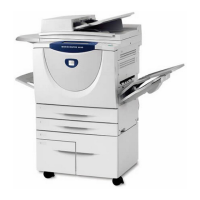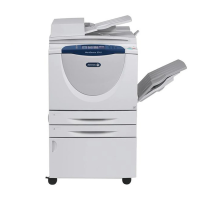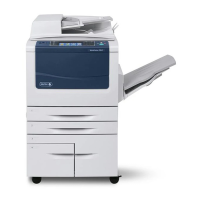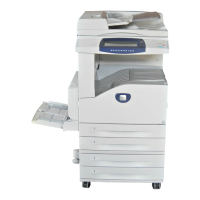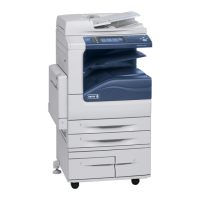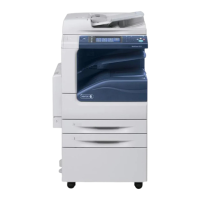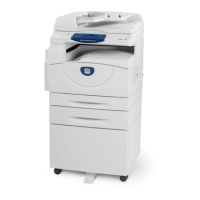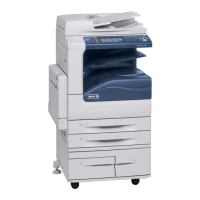







Do you have a question about the Xerox WORKCENTRE 5775 and is the answer not in the manual?
| Functions | Print, Copy, Scan, Fax |
|---|---|
| Print Technology | Laser |
| Print Speed (Black) | 75 ppm |
| Print Resolution | 1200 x 1200 dpi |
| Copy Speed (Black) | 75 cpm |
| Copy Resolution | 600 x 600 dpi |
| Scan Resolution | 600 x 600 dpi |
| Scan Destinations | Email, Network Folder, USB |
| Fax Speed | 33.6 kbps |
| Fax Transmission Speed | 3 seconds per page |
| Duplex Printing | Yes |
| Connectivity | USB, Ethernet, Wi-Fi |
| Monthly Duty Cycle | 300, 000 pages |
| Reduction/Enlargement | 25% to 400% |
| Maximum Paper Size | SRA3 |
| Display | Color Touch Screen |
Lists security functions to be set up by the System Administrator, including Image Overwrite, Encryption, IP Filtering, etc.
Lists services considered part of the evaluated configuration and should be enabled by the System Administrator.
Instructions to change the Administrator password and reset the Tools password periodically.
Recommends establishing unique user accounts with appropriate privileges for all users.
Recommends changing passcodes like Smart Card, Secure Print, and Scan To Mailbox regularly.
Specifies that job deletion should be restricted to System Administrators only.
Ensures all pathways and services are locked for access by authenticated users only.
Explains that jobs are stored on the hard disk drive and discusses security features for this.
Advises on setting crypto policy for SSL/TLS, recommending SSLv3.1 or TLSv1.0.
States that a valid machine name and domain are required for SSL to function properly.
Details configurations and best practices when utilizing Secure Sockets Layer (SSL).
Provides instructions for enabling HTTPS (SSL) and managing security certificates.
Details how to enable and use SSL for secure scanning jobs.
Recommends using HTTPS for sending scan jobs to remote IT products for consistency.
Recommends specific protocol choices for remote authentication to maintain configuration consistency.
Advises setting the device for local authorization to align with the evaluated configuration.
States that data encryption must meet the FIPS 140-2 Standard for the evaluated configuration.
Highlights specific events and considerations when viewing the Audit Log.
Emphasizes the importance of daily download and review of the Audit Log.
Warns against creating IP filtering rules that block Web UI access via port 80.
Notes that user data encryption is enabled by default and requires periodic checks.
Guides the System Administrator on installing and configuring the Embedded Fax Card.
Explains how to enable session inactivity timers via the Web UI.
Describes a feature to verify executable code integrity by comparing hash values.
Details how to enable the Scan to Mailbox feature using the Web UI.
Specifies enabling Embedded Fax Secure Receive and disabling Local Polling.
Recommends submitting print jobs as secure print jobs for enhanced security.
Sets the Secure Print function to require user ID for releasing secure print jobs.
Advises checking for the latest certified software versions before upgrading.
Recommends disabling customer software upgrades via the network for configuration integrity.
Details how to enable domain filtering for E-mail to restrict scan job destinations.
Configures the Hold All Jobs function for secure queue management and administrator control.
Lists features and protocols that were not part of the evaluated security configuration.
Guides on enabling and configuring SNMPv3, noting its dependency on SSL/HTTPS.
Recommends changing default SNMP v1/v2c community strings to random names.
Advises customers to subscribe to the RSS service for security information.
Stresses installing the device in a standard office and making staff aware of security.
Instructs customers to contact Xerox Support for software issues and SPAR process.
Advises System Administrators to periodically review machine configurations for security.
Discusses IPv4 address assignment and recommends disabling 'Self Assigned Address' option.
Explains potential data issues after system interruptions like power loss.
Details how IPv6 can be re-enabled after a software upgrade affects its status.
Recommends establishing unique Scan-to-Mailbox mailboxes for each authenticated user.
Specifies that Remote Polling should only be used by the System Administrator.
Notes that printing of Embedded Fax confirmation reports is not included in evaluation.
Informs users that workflow scanning paths should start with one '\'.
Emphasizes the need for appropriate user training on secure system usage.
Highlights security-relevant windows available from the Local UI for System Administrator.
Allows users to run diagnostics on the User Interface software.
Informs users when the system is performing encryption or decryption of data.
Explains how to access on-line help pages from the Web UI.
Allows defining the minimum encryption key length for security certificates.
Sets whether information transmitted via SMB will be encrypted.
Manages domain controller certificates for smart card authentication.
Installs a domain controller certificate for smart card authentication.
Configures the system to perform LDAP queries for user authentication domains.
Allows bypassing the filename locking feature for scanned files.
Allows the System Administrator to grey out the 'Other Queue' button on the Local UI.
Allows setting secure print PINs to be alphanumeric characters.
Allows users to change system attributes related to PDLs.
Suppresses the display of job names on the Banner Page.
Sets the XML job log file format.
Selects the case (upper/lower) for created file extensions.
Secures the device's email service.
Enables the device to accept printing jobs identified as binary files.
Generates Xerox Standard Accounting reports with User IDs.
Selects whether the Postscript Filter uses strict or loose interpretation.
Clears the Web Services IP Address Lockout cache.
Resets the device's Service Registry to its default values.
Sets the maximum number of jobs listed in the device's job queues.
Chooses how the device renders space characters within barcode fonts.
Selects the compliance option to be followed when DHCP v6 is used.
Views the contents of the device's Service Registry.
Views the selectable list of diagnostics Special Purpose Pages.
Views the Color Copy Control test results.
Enters the desired PCL advanced configuration paper size code.
Controls how the device performs Kerberos authentication.
Downloads the DLM PCL forms into the device.
Enables multiple pages per JBIG2 dictionary feature.
Allows non-admin users to view the WebUI Configuration Page.
Enables the device to send only NTLM Version 2 protocol.
Allows the System Administrator to permit custom size paper for print jobs.
Enables the display of the CAC/PIV feature.
Controls SSL cipher strength, enforcing bit encryption keys.
Enables/disables filtering of RAW IP print stream for PostScript control-T character.
Sets whether CRU Low/Reorder messages are enabled/disabled.
Enables the Cost Control feature when Secure Access and network accounting are enabled.
Installs a Network Controller version, potentially removing it from evaluated configuration.
Provides hyperlink pointers to each Web UI screen organized by Web UI tab.
Notifies users when the device needs to exit 'Sleep Mode' to make changes.
Explains that specialized changes may take the system out of certified configuration.
